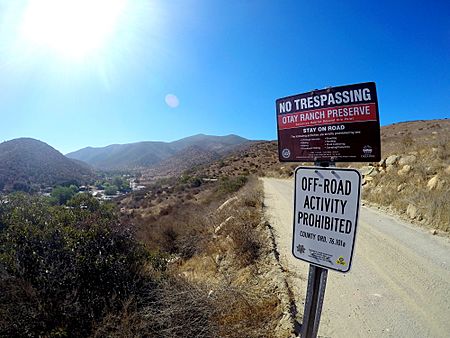Cedar Canyon, San Ysidro Mountains facts for kids
Cedar Canyon is a beautiful valley located in San Diego County, California. It's part of the San Ysidro Mountains and stretches from the northern slopes of Otay Mountain all the way up to Otay Lakes Road. A significant part of this canyon is even protected as part of the Otay Mountain Wilderness, which helps keep its natural beauty safe for everyone.
Contents
What is Cedar Canyon?
Cedar Canyon is a long, narrow valley carved out by natural forces over many years. It's a place where you can find diverse plant life and animals, making it an important natural area in Southern California.
Where is Cedar Canyon Located?
This special canyon is found in the southern part of San Diego County. It starts near the base of Otay Mountain, which is close to the U.S.-Mexico border, and extends northward towards Otay Lakes Road. This road is known for the scenic Otay Lakes, which are reservoirs that provide water to the region. The canyon's location within the San Ysidro Mountains means it has a unique landscape with rolling hills and rugged terrain.
What Makes a Canyon Special?
Canyons like Cedar Canyon are formed by rivers or streams slowly eroding the land over thousands or even millions of years. This process carves out deep grooves in the earth, creating steep sides and often revealing layers of rock that tell a story about the Earth's history. Canyons often create unique microclimates, meaning the weather conditions inside the canyon can be different from the surrounding areas. This can lead to special plants and animals thriving there.
Nature and Wildlife in Cedar Canyon
Cedar Canyon is home to a variety of plants and animals, making it an important part of the local ecosystem. Its protected status helps ensure that these natural habitats remain undisturbed.
Plants of the Canyon
The plant life in Cedar Canyon is typical of the chaparral and coastal sage scrub environments found in Southern California. You might see:
- Chaparral: Dense shrubs with tough, leathery leaves that can survive dry conditions and occasional wildfires. Common plants include chamise and various types of manzanita.
- Coastal Sage Scrub: A mix of aromatic (smelly) shrubs like California sagebrush, black sage, and white sage. These plants are adapted to the dry, sunny climate.
- Oak Trees: In some parts of the canyon, especially where there's more moisture, you might find different kinds of oak trees providing shade and acorns for wildlife.
Animals You Might See
Cedar Canyon provides a home for many different animals. While some are shy and hard to spot, others are more commonly seen. Animals that might live here include:
- Mammals: Coyotes, bobcats, deer, and various small rodents like California ground squirrels.
- Birds: Many bird species, including California quail, roadrunners, and various raptors (birds of prey) like red-tailed hawks, can be seen flying overhead or nesting in the shrubs.
- Reptiles: Different types of lizards and snakes are common, enjoying the warm, sunny environment.
Protecting the Wilderness
A significant portion of Cedar Canyon is part of the Otay Mountain Wilderness. A wilderness area is a special type of protected land where human activity is limited to preserve its natural state. This means there are no roads, buildings, or permanent structures. The goal is to keep the land wild and untouched, allowing plants and animals to thrive without much human interference. This protection is crucial for maintaining the biodiversity of the region.
History of Cedar Canyon
Like many natural areas in California, Cedar Canyon has a long history, from its earliest inhabitants to modern conservation efforts.
Early Inhabitants
Before European settlers arrived, the land around Cedar Canyon was home to various Native American groups, including the Kumeyaay people. They lived off the land, using its resources for food, shelter, and tools. They had a deep understanding of the local plants and animals and used the natural landscape for their daily lives and cultural practices. Evidence of their presence, such as ancient trails or artifacts, can sometimes be found in these areas.
Modern History and Conservation
In more recent times, the land around Cedar Canyon has seen various uses, including ranching and limited development. However, as the importance of preserving natural habitats became clearer, efforts were made to protect areas like Cedar Canyon. The establishment of the Otay Mountain Wilderness in 1999 was a major step in ensuring that this beautiful valley remains wild and protected for future generations to enjoy and learn from.
Why is Cedar Canyon Important?
Cedar Canyon is important for several reasons. It serves as a vital habitat for many plant and animal species, contributing to the overall health of the local ecosystem. It also acts as a natural corridor, allowing wildlife to move between different areas. For people, it offers opportunities for outdoor activities like hiking and nature observation, providing a chance to connect with the natural world. Protecting places like Cedar Canyon helps us understand and appreciate the natural beauty and biodiversity of our planet.


